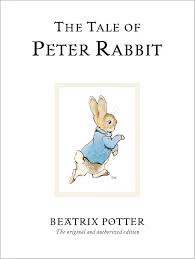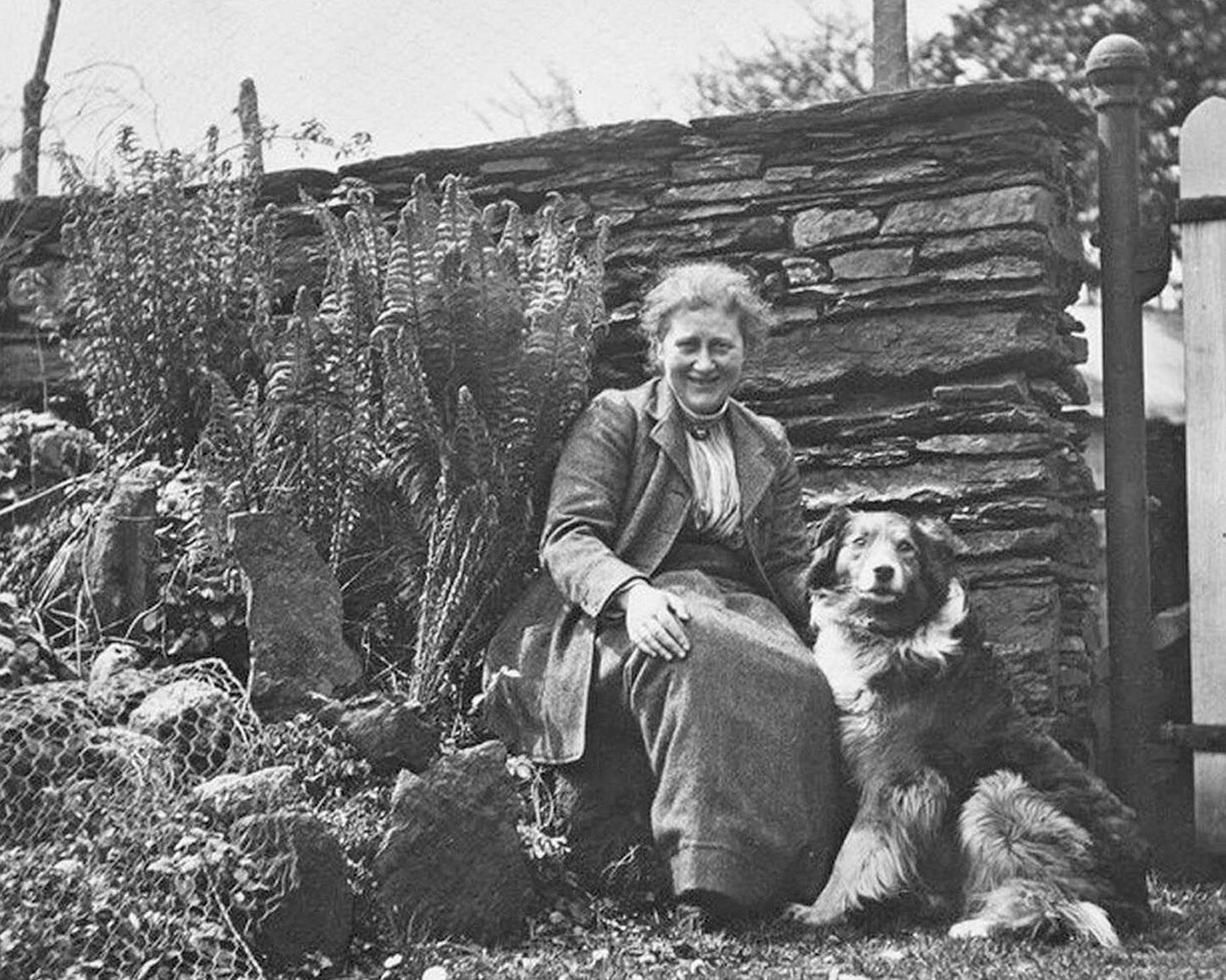I’m just back from a few days away in the Lake District. The Lakes are beautiful at anytime of the year, but in the spring sunshine they are magical. We stayed in Rose Cottage on the shores of Lake Bassenthwaite, where rare Ospreys nest.
In the back garden, there is a little red gate that leads directly into these woods, where the pine-scented air is so fresh you wish you could bottle it and take it home. I escaped through that gate at every opportunity. Walking has the same escapist appeal for me as curling up with a good book. In the Lakes, walking and reading are intimately connected. Over 4,000 acres of land in the Lakes was bought by none other than Beatrix Potter, who bequeathed it to the National Trust. Every fell and hill top we walked on, I found my thoughts wandering to the enigmatic author, whose books were a part of my childhood.
Here’s something I wrote about Beatrix Potter last year for a newspaper… I hope you enjoy.
The Lake District, 1930. The rain is coming down in sheets as a solitary figure trudges through the sodden landscape. The sacking on her head is soaked through and her woollen skirt hangs heavy, weighing down her diminutive figure. She passes a pedlar who nods in commiseration. ‘A rough night for the likes of thee and me,’ he remarks.
He would have been surprised to know that she was neither penniless, nor destitute. In fact, it was none other than wealthy, best-selling author Beatrix Potter, who far from being homeless, owned thousands of acres of the surrounding countryside including numerous farms.
Helen Beatrix Potter never did have much time for the social conventions – and that included dressing ‘appropriately’. By 1930, her passion was for sheep farming so why – she reasoned – dress as anything other than a sheep farmer?
A barrister’s daughter, born into an upper middle class Victorian family, Beatrix Potter defied her family early on by refusing to show any interest in entering an advantageous marriage. She once, while recovering from rheumatic fever, wrote in her diary: ‘I am well content to have a red nose and a shorn head, I may be lonely, but better that than an unhappy marriage.’
Loneliness was a recurring motif in Beatrix’s life. Born in 1866, she was a shy child who was raised largely by a governess and had limited interaction both with her parents and with other children save for her younger brother Bertram, who was eventually sent away to boarding school. The family lived at 2 Bolton Gardens in West London, where the little girl kept an assortment of pets, including a bunny called Benjamin H Bouncer, later the inspiration for Benjamin Bunny and even a duck, grandly named the Duc d’Orleans.
When Bertram went away to school, Beatrice continued to draw and was enrolled at the National Art Training School where she developed her skills alongside a burgeoning interest in natural sciences – fungi in particular (although presenting her work to learned societies was difficult because women were mostly excluded from their ranks).
In 1893, the 27-year-old Beatrix penned The Tale of Peter Rabbit and though she self-published it for pleasure, she soon attracted the interest of Frederick Warne Publishers. It was an instant success when published in 1902 and within a year there were a further five editions. ‘What an appalling quantity of Peter,’ she remarked, in her typically dry style.
Beatrix’s commercial success also brought her together with Norman Warne. ‘Norman was her editor,’ explains Helen Antrobus, from the National Trust. ‘It was an equal and creative partnership which led to love. Beatrix saw her path to independence through her writing and Norman was always encouraging. When she told him about the book she was writing, Two Bad Mice, he sent her dolls house furniture from Hamleys so she could copy it. He was also a gifted amateur carpenter in his spare time and made a dolls house for his niece, which Beatrix greatly admired.
‘They had a truly collaborative partnership. She listened to him and took his advice on her books.’
But the attraction went beyond Norman’s creative skills and industrious work ethic.
‘He came from a very big family, they had a house in Bedford Square, London,’ says Helen. ‘There were lots of brothers and sisters, nieces and nephews. The complete opposite of what she had in Kensington and she loved going there. She was especially close to his sister Millie.’
Their courtship was of its time; genteel, innocent and conducted through a flow of letters, sadly few of which remain today. They would never have been allowed to be alone, unchaperoned together.
‘I don’t know that you could say that Beatrix loved him in the way we understand it today. I think she deeply admired him,’ says Helen. ‘He would have been an escape from her family home, and a chance to enter into a marriage to someone who wouldn’t stop her from writing and creating.’
By the time Norman proposed in 1905, four years after they had first met, Beatrix was 39 – a spinster as far as Victorian society was concerned. Beatrix was smitten – her unbending mother, however, was not.
‘Her mother Helen didn’t see Norman as a suitable match for her daughter,’ says Helen. ‘She saw his family as being trades people, which is ironic considering the Potters were from Lancashire Industrialist stock. There are letters back and forth between her and Norman, with Beatrix saying of her mother, “People who only see her casually do not know how disagreeable she can be when she takes dislikes”.’
The engagement wasn’t announced, despite Beatrix wearing Norman’s gold engagement ring and at the end of July 1905 she accompanied her family on holiday to North Wales. Perhaps in the tranquil surroundings, she hoped to gently bring her parents round to the love match? But we shall never know whether they would have come to accept Norman as a son-in-law.
On 24 August she wrote Norman a tongue-in-cheek letter about their future life together – ‘a silly letter all about my rabbits’, she recorded in her diary – but he was never to read it. The next morning she received a telegram from Norman’s sister Millie telling her that he was gravely ill.
Her mercy dash from Wales was to no avail, he had already died by the time she reached his home in Bedford Square. One can only imagine at the depths of despair this tragic and cruel turn of events must have wrought on Beatrix. There are no clues as to how she copes in her diary as in the days after, she abruptly stops writing.
Norman had died from a rare form of leukaemia, aged just 37. It was a heartbreak which altered the course of Beatrix’s life forever. ‘After his untimely demise, I don’t think she ever really stopped searching for a sense of home,’ Helen says. This explains why, three months after her fiancé’s death, using royalties from her books, she bought Hill Top farm, Near Sawrey, a house she described as “nearly a perfect a place as I have ever lived”.
The solitude of the Lake District worked its healing power on the grief-stricken Beatrix and, aged 47, she met and married a respected local solicitor called William Heelis with whom she had a 30 year relationship. However, she wore Norman’s ring on her right hand for the rest of her life. Tellingly, she was nervous to tell Norman’s sister about her nuptials and did so by sending Millie a piece of wedding cake. The Warne family were by all accounts delighted. The beautiful dolls house furniture he gave her remains at National Trust managed Hill Top farm to this day, as do many of her treasured belongings.
Beatrix described Hill Top as the “place I go to be quiet and still with myself. This is me, the deepest me.” Perhaps that explains why Beatrix didn’t live there full time. She and William settled in nearby Castle Cottage, preferring instead to leave it as her sanctuary.
Beatrix’s love of nature never left her, and she later became an award-winning sheep-farmer, who had a profound impact on the conservation of the Lake District. She lived during both world wars so as a farmer she grew food as part of the national effort and also campaigned against the conscription of horses.
Between the wars, Beatrix witnessed developers buying up swathes of land in the area, building hotels to cater for the burgeoning tourist trade, and became determined to protect the countryside. In the last thirty years of her life, she bought an astonishing 4,000 acres of land and bequeathed it all to the National Trust to protect it for future generations.
By the Second World War, with most of her fortune invested in the great outdoors, there is a cruel irony that Beatrix’s failing health forced her to stay indoors. She relied on her imagination to allow her to roam. “Thank God I have the seeing eye,” she wrote. “As I lie in bed I walk step by step on the fells and rough land seeing every stone and flower and patch of bog and cotton grass where my old legs shall never take me again.”
Beatrix died on 22nd December 1943 of bronchitis at her home in the Lake District. She was 77. The National Trust described her as a “many-sided genius.” Legions of fans remember her as the inventor of Britain’s most mischievous bunny. To date she has sold over 250 million books, which have been translated into forty-six languages.
But however you choose to remember one of our greatest writers, it must be done in the context of her legacy. Beatrix Potter was visionary, the only woman of her time to make her fortune, then give it all away to preserve the landscape she loved, as happy in muddy clogs tramping the hills as she ever was surrounded by wealth and privilege.
‘It is only outdoors in the beauty of nature that she felt at peace with herself,’ says Helen. ‘She redefined success, proving that happiness isn’t found along the path that is laid out for you, but the one you forge.’










Thank you very much for this lovely article of Beatrix Potter’s life & generosity. A remarkable individual indeed and a wonderful example for us all.
I so loved your article! I read a biography of her years ago; it was very interesting, to me, anyway. Would love to go visit those acres.